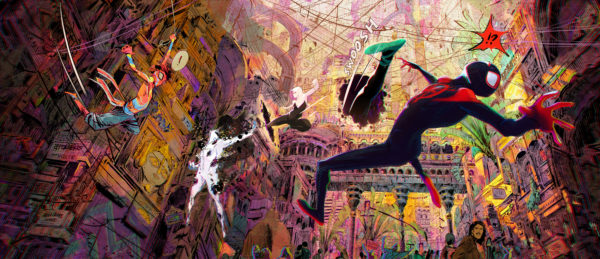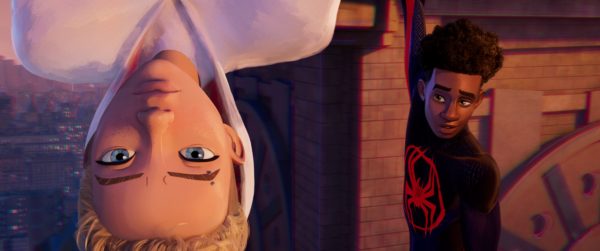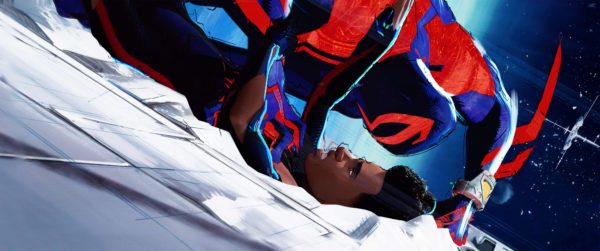
Accusations that superhero movies are derivative, unoriginal, or uninspired are firmly quashed with the release of Joaquim Dos Santos, Kemp Powers, and Justin K. Thompson‘s Spider-Man: Across The Spider-Verse.
The new film is a sequel to 2018’s Into the Spider-Verse, the animated film that introduced Miles Morales (Shameik Moore) as a Brooklyn teenager who is bitten by a radioactive spider and takes on the Spider-Man mantle. Not only was the original film a critical and commercial smash, it took home the Oscar for Best Animated Film, and influenced the visual aesthetic of future animated films.
Expect more of the same with this new entry, which ups the ante in terms of animation and homages/Easter Eggs without sacrificing the original film’s core messaging about identity, family and responsibility.
In Across The Spider-Verse, it’s nearly a year later and Miles and Gwen Stacy (Hailee Steinfeld) are back in their respective universes and missing each other. Miles is staying busy, hiding his secret identity from his parents, Jefferson Davis (Brian Tyree Henry) and mother Rio (Luna Lauren Vélez), battling crime, and preparing for College. He’s tired of being treated as a child, but he struggles to communicate with his father unless he’s in costume.
Gwen’s life is even more complicated. In an extended opening sequence, we learn Gwen’s back story as her father George Stacy (Shea Whigham) hunts Spider-Woman after she is implicated in the death of her universe’s Peter Parker. In a moment of desperation, Gwen is recruited by Miguel O’Hara (Oscar Isaac) – aka Spider-Man 2099 – to join the Spider-Society and help protect all of the universes. A perk of the job is that she’s outfitted with a special bracelet that prevents glitching when she travels between timelines.
Gwen returns to Miles’ world in order to apprehend an anomaly: The Spot (Jason Schwartzman), a “villain of the week” who blames Miles for the interdimensional portals that now cover his body. Although she’s been warned by her mentor, Jessica Drew (Issa Rae) not to see Miles, Gwen can’t resist reconnecting. With her attention divided, The Spot grows more powerful and escapes into other universes, prompting Gwen (and secretly Miles) to set off in pursuit.

One of the obvious joys of the film is how the world (universe?) opens up to accommodate new stories and characters. When Into The Spider-Verse was introduced, it featured a handful of Spider-Man variants; here there are 100s (if not thousands), with the vast majority of them paying off years of lore. Just like the first film, they’re also rendered in the distinct look of their respective comic, so, for example, Hobie Brown (Daniel Kaluuya), a Black British punk-rock variant is made out of paper cut-outs.
The different looks should be jarring or disconnected, but Dos Santos, Powers, Thompson and their animators make it work in a way that is simultaneously distinct and seamless. The interweaving of animation styles, combined with dynamic action sequences, is even more thrilling in this second go-around. At times the boundary pushing action is almost overwhelming, but overall the experience is exciting and bold.
Of course none of this would work if the storytelling wasn’t also exceptional. Despite the mass influx of new Spider-People, Across The Spider-Verse screenwriters Phil Lord, Christopher Miller, and David Callaham never lose sight of the characters’ personal narratives. Gwen is adrift after being cut off from her father, while Miles is frustrated that he’s not allowed to grow up and be taken seriously.
These are ultimately individual stories with personal stakes in world-ending adventures, which is what superhero narratives do best. Across The Spider-Verse understands perfectly well that intimate conversations can be just as impactful as cataclysmic fight sequences.

Take, for instance, Gwen’s reunion with Miles early in the film. He’s just been grounded after a fight with his parents and she’s basically estranged from her father, so the pair sit upside down, stare the Brooklyn skyline, and talk about their teenage problems. It’s a simple scene that (re)establishes the bond they have, teases their inevitable romance, and lays out the emotional foundation for the adventure to come. But it’s also just a lovely human scene.
The film is filled with these kind of moments: Rio giving Miles permission to go after Gwen if he promises to return with a cake, Spider-Man’s advice to Jefferson on giving his son space, and George Stacy and Gwen’s reunion late in the film. They’re quiet, introspective, and often deeply intimate moments that slow down the film’s breakneck pace so that the audience can breathe and appreciate these characters.
Without these moments, the elaborate, frenzied action sequences are just visual noise.
Because Across The Spider-Verse invests in its people, the audience invests in their journey – whether its a simple journey to the guidance counsellor or a trip all the way to Pavitr Prabhakar (Karan Soni)’s Mumbattan.
It’s a flawless film and easily one of the best of the year. 5/5

Other Observations:
- The aforementioned Mumbattan sequence is a visual delight and the first of two stand-out action set-pieces (the other being Miles’ escape from Miguel and the Spider-Society’s head quarters). What these animators have achieved is truly jaw-dropping.
- Also: would watch a spin-off with Spider-Man India in a heartbeat.
- The film’s tendency to introduce new Spider-People with a brief visual aside that references their comic and origin story is both helpful and smart.
- The jokes in the Spider-Society scenes are fast and frequent, paying off various levels of audience awareness with innumerable references. The appearance of original 60s Spider-Man, clips of the live action films, and the iconic “Spider-Man points at himself” meme all drew appreciative audience responses.
- While Hobie is possibly the most visually distinct character (aside from the sketch-look of The Spot), Gwen’s pastel watercolour world is also worth mentioning. Changing the colour scheme based on her and her father’s moods is a particularly bold design choice.
- It’s important to remember that Across The Spider-Verse is essentially part one of a two parter because the film’s abrupt end during what seemed like the rising action took a lot of people by surprise. Thankfully the credits clarify (Bond style) that Miles Morales will return in Beyond The Spider-Verse.
- Finally, considering the prominence of Spider-Cat on the poster, the character’s limited screen time is disappointing. I’m gonna need that furball, as well the OG team from Into The Spider-Verse, to have a larger role in this third film.
Spider-Man: Across The Spider-Verse is now in theatres